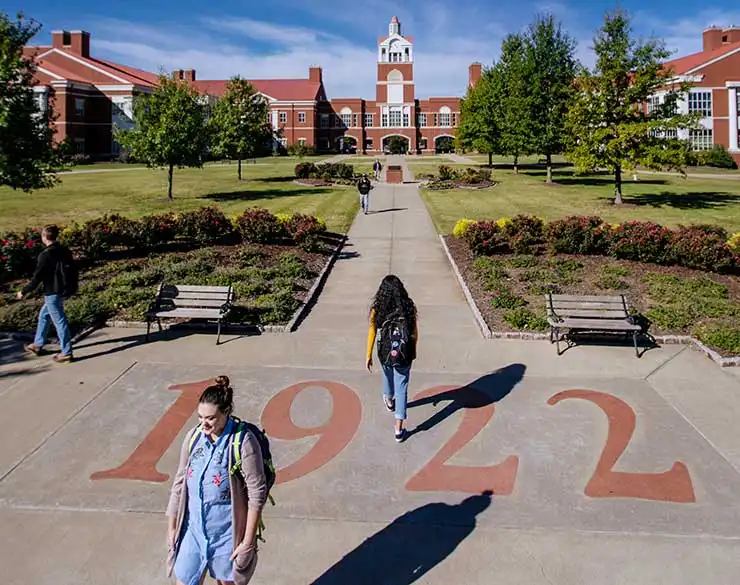Background
Murray State University, founded in 1922, has built a reputation for embracing innovation while honoring its longstanding traditions. As a rural institution with five regional campuses scattered across eastern Kentucky, the university has always faced the challenge of managing a complex parking environment. The main campus in Murray serves as the central hub for permit sales, enforcement, and administrative tasks, where the pressures of daily operations are most acute.
From early on, Murray State recognized the value of technology in easing operational burdens. The university was an early adopter of digital permits and integrated systems, initiatives that have streamlined parking management over the years. In 2018, Murray State further enhanced its capabilities by implementing a Genetec License Plate Recognition (LPR) system. This move improved enforcement efficiency by providing a more accurate method for reading license plates—a key component in managing the large volume of vehicles on campus during routine days and special events alike.
Parking at Murray State goes beyond the simple act of managing vehicles. It involves a comprehensive system that caters to the varied needs of students, faculty, employees, and an ever-increasing number of visitors, particularly during athletic events and other high-traffic campus activities.
Prior to adopting Cardinal Tracking’s TickeTrak solution, the process of handling visitor permits and managing vendor accounts involved workarounds and manual interventions, underscoring the need for a more integrated approach. Although regional campuses were allowed to sell digital permits, parking regulations were primarily enforced only at the main campus, highlighting the unique operational challenges the university faced.
The Challenge
Change became inevitable when the previous parking system provider was sold and eventually phased out. Murray State found itself at a critical juncture as its old system became outdated and unreliable. The university was compelled to search for a new solution—one that would not only replicate the familiar functionalities but also introduce innovative features to meet evolving demands.
According to Katrina Carr, Murray State’s Parking Manager, the decision-making process was comprehensive and deliberate. The university dedicated an entire summer to reviewing potential vendors, understanding that the new system needed to deliver a fully digital, virtual permit experience and an updated LPR system.
The goal was clear: ensure that visitor permits were managed seamlessly, even during periods of high demand. With frequent campus events and a significant influx of visitors, the parking office needed a solution that could efficiently process large volumes of permit requests while maintaining accuracy.
One of the major challenges was the lack of an integrated solution for handling visitor permits and large vendor accounts where one vendor has several vehicles, but only a few may be on campus at one time. Although digital permits and e-ticketing were already part of the university’s operations, there was no dedicated tool to manage scenarios where a single vendor might have numerous vehicles requiring permits. The absence of batch permit functionality meant that staff often had to resort to manual processes, which could be time-consuming and prone to error.
Adding to the complexity was an ongoing construction project on campus that temporarily removed one of the largest parking lots. While this challenge was more logistical than technological, it underscored the necessity for a flexible, responsive system capable of adapting to unexpected changes without disrupting daily operations.
The Solution
Faced with these challenges, Murray State selected Cardinal Tracking’s TickeTrak solution. More than just a software upgrade, TickeTrak represented a shift toward a more integrated and efficient approach to parking management. A key feature introduced by Cardinal Tracking during the integration was OffStreet, a program specifically designed to manage visitor permits. Murray State also used it to handle large vendor accounts. Unlike previous systems, OffStreet offered a dedicated platform that could handle the volume and complexity of permit requests during high-traffic events.
Before OffStreet, managing vendor data during major events was cumbersome, with the parking office often overwhelmed by the need to manually process batch permit requests. With the introduction of Ticketrak’s integration with OffStreet, the process became more automated and organized. The platform enabled the parking office to efficiently upload vendor data and manage permits in a way that had not been possible with the former system, effectively bridging a long-standing gap in Murray State’s operations.
The transition to the new TickeTrak system was carefully orchestrated. Beginning in March, a dedicated project team—comprising representatives from enforcement, customer service, accounting, payroll, IT, and security—met weekly to ensure that the implementation progressed smoothly.
These meetings were pivotal in aligning the various departments and proactively addressing any issues. For example, when the installation of new Genetec cameras experienced a brief delay, the team was able to implement contingency measures. Preemptive warnings were issued to permit holders, ensuring that the temporary lapse in enforcement did not significantly impact overall operations.
Training was central to the successful rollout of TickeTrak. Cardinal Tracking’s project manager led detailed sessions for back office staff, covering everything from data conversion and the integration of OffStreet to the generation of customized reports. Enforcement officers, who had previously relied on desktop-based systems for issuing tickets, were introduced to updated handheld devices for scanning license plates.
While the shift to a new method did involve a learning curve—especially as officers adjusted to scanning plates rather than manually writing tickets—the training was structured to facilitate a smooth transition. On-site technicians from Genetec were also available to provide immediate support, ensuring that any initial challenges were quickly resolved.
A crucial aspect of the implementation was the meticulous data conversion process. Murray State’s team collaborated closely with Cardinal Tracking to ensure that all historical data was accurately transferred to the new system. This effort was vital not only for maintaining continuity but also for preserving past records, which are sometimes required for appeals or audits. The careful migration of data guaranteed the integrity of previous records was maintained, eliminating potential disruptions to ongoing administrative processes.
Another significant improvement was the reporting capability offered by TickeTrak. Under the old system, Murray State was limited to canned reports, which often meant submitting support tickets for any custom data needs. With the new system, the back office gained the flexibility to build custom reports on demand.
Cardinal Tracking’s commitment to customization further distinguished TickeTrak from previous solutions. Recognizing that no two campuses are identical, Cardinal Tracking’s team worked to tailor the solution specifically for Murray State.
Whether refining OffStreet’s functionality to better manage vendor permit requirements or adjusting the user interface for the appeals process, the vendor was responsive and flexible. Their willingness to develop new programs and make real-time adjustments meant that the solution was not only effective at launch but also adaptable to future needs.
The Results
Since the full implementation of TickeTrak, Murray State University has observed significant improvements in its parking operations. The new system has addressed many of the challenges that had previously hampered efficiency and accuracy.
One of the most noticeable changes has been the seamless management of digital permits. The introduction of OffStreet has been particularly transformative, simplifying the process of handling large volumes of visitor permits and managing vendor accounts.
During events and periods of high demand, the parking office can now upload and manage vendor data quickly, ensuring that permits are issued correctly and without delay. This automation has not only streamlined day-to-day operations but has also reduced the likelihood of errors that previously resulted from manual processing.
Enforcement processes have also benefited from the system’s upgrade. With the updated Genetec LPR system, enforcement officers can now scan license plates more rapidly and with greater accuracy. As a result, officers are able to maintain campus safety more effectively, focusing on their duties rather than troubleshooting outdated technology.
On the administrative side, the enhanced reporting tools have empowered Murray State’s back office. The ability to generate customized reports on demand has provided administrators with timely insights into parking operations. These reports have proven invaluable for tracking trends over time, managing staffing levels, and ensuring that the university remains within its budgetary targets. For instance, the automated nightly data uploads ensure that the latest information is always available, enabling more informed decision-making and better resource allocation.
The transition process itself has been successful mainly due to the collaborative efforts of Murray State’s internal teams and Cardinal Tracking’s implementation specialists. Weekly meetings that brought together stakeholders from multiple departments helped ensure that everyone was on the same page. This collaborative approach not only smoothed the transition but also fostered a sense of shared ownership over the new system.
Katrina Carr’s experience highlights the importance of thorough preparation and ongoing support during a major system transition. The project team faced a steep learning curve at the outset. Enforcement officers had to adjust to a new ticketing
method using handheld devices, and back office staff had to learn a more flexible yet complex reporting system.
However, the structured training sessions and hands-on support provided by Cardinal Tracking ensured that these challenges were overcome efficiently. Today, the improvements are evident in the enhanced operational efficiency and the overall satisfaction among both staff and system users.
The strategic benefits of TickeTrak extend beyond the immediate operational improvements. Cardinal Tracking’s approach—demonstrated through features like OffStreet and the enhanced LPR system—has positioned the university to handle future challenges more effectively. The solution not only meets the immediate needs but also provides a robust platform for future enhancements, ensuring that Murray State remains at the forefront of campus management technology.
Reflecting on the transition, Cardinal Tracking’s TickeTrak solution has delivered tangible value. The university now manages its parking operations with greater accuracy and efficiency while maintaining comprehensive historical data for appeals and audits. The user-friendly experience offered by the new system has benefited students, employees, and visitors alike, ensuring that the entire campus community experiences fewer disruptions and a more streamlined process.
Ultimately, the journey from an outdated, manual system to a modern, fully integrated solution is a powerful example of how thoughtful technology integration can transform campus operations.
Cardinal Tracking’s adaptive approach has not only met the immediate challenges faced by Murray State University but has also laid a strong foundation for ongoing improvements. For Murray State, the move to TickeTrak represents a significant step forward in campus management—a change that supports operational efficiency, enhances user experience, and sets the stage for future innovation.
Cardinal Tracking’s TickeTrak solution has proven to be a valuable asset for Murray State University. Through careful planning, comprehensive training, and a commitment to customization, the new system has delivered measurable improvements in digital permit management, enforcement efficiency, and reporting capabilities.
Murray State’s experience stands as a compelling example for other institutions seeking to modernize their campus operations, demonstrating that with the right partner, even the most complex challenges can be transformed into opportunities for growth and efficiency.




